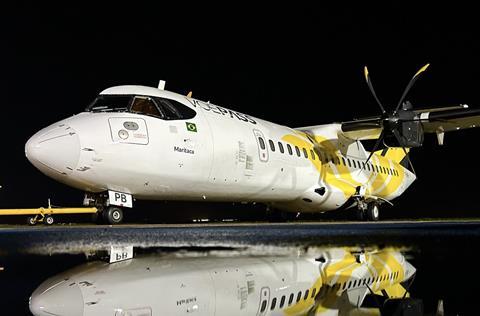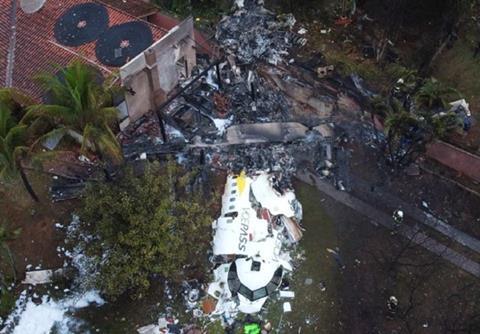Icing has emerged as a primary line of inquiry into the fatal Voepass ATR 72-500 crash near Sao Paulo, during which the aircraft slowed, stalled and entered a flat spin from which the crew did not recover.
Preliminary findings from Brazilian accident investigation authority CENIPA show the aircraft, which departed Cascavel for Sao Paulo Guarulhos on 9 August, was dispatched with one of its two air-conditioning packs inoperative.
The air-conditioning packs use bleed air to provide pressurisation and cabin heat, and also feed the engine and wing de-icing systems.
Dispatch with an inoperative pack is acceptable as long as certain limitations are taken into account. Conditions for the Voepass aircraft included restricting its altitude to 17,000ft.

After the ATR took off from Cascavel’s runway 15, propeller anti-icing was switched on.
As it climbed through 13,000ft an electronic ice-detector sounded, and the crew turned on the airframe de-icing system. But shortly afterwards, says the inquiry, the crew remarked on an airframe de-icing fault and switched the system off.
Over the next hour of flight the electronic ice-detector issued at least five alerts, each lasting several minutes, but the inquiry indicates that the airframe de-icing system was only turned on as the aircraft neared Sao Paulo and the crew was co-ordinating with the airline’s operations control at Guarulhos.
About 1min later the aircraft’s performance monitor – which checks for higher-than-expected drag from ice accumulation – warned that the cruise speed was low. The aircraft was travelling at 191kt.
As the crew started briefing for the approach and contacted Sao Paulo approach control, the airframe de-icing was again turned off.
Approach control instructed the aircraft to remain at its cruise altitude of 17,000ft owing to traffic congestion at 15,000ft from a Gol Boeing 737 and a LATAM Airbus A321.
The ATR had slowed to 184kt and the performance monitor issued a higher-level alert, indicating a further degradation. This alert sounded as the crew was exchanging communications with air traffic control.
Upper atmospheric data shows the air was “very humid” which, combined with sub-zero air temperatures, “favoured the occurrence of severe aircraft icing” between 12,000ft and 23,000ft, says the inquiry.
As the aircraft continued to hold for clearance, the first officer remarked that there was “a lot of icing”, and the crew turned on the airframe de-icing system for the third time.
Controllers instructed the ATR to fly to the SANPA waypoint at 17,000ft, advising the crew that descent clearance would follow in about 2min.
The crew acknowledged this instruction, and the aircraft commenced a right turn towards SANPA.

But as it turned, with its speed having fallen to 169kt, the aircraft began to vibrate, and a stall alert activated along with a warning to increase speed. The aircraft rolled 52° left, then 94° right and turned 180° clockwise.
This turn then reversed to anti-clockwise and the ATR descended in a flat spin, fully rotating five times before striking the ground near Vinhedo.
None of the 58 passengers and four crew members survived.
CENIPA stresses that final conclusions have yet to be drawn over the accident, and several avenues of inquiry are being followed.
“It is important to emphasize that there is no single factor for an accident, but rather several contributing factors,” says investigator-in-charge Lt Col Paulo Mendes Froes.
“In [this case] loss of control of the aircraft occurred during the flight under conditions favourable to the formation of ice, but there was no declaration of emergency or report of adverse weather conditions.”
He points out that the aircraft was certified for flight in icing conditions and the crew had each logged over 5,000h. The inquiry states that the captain had 665h on type compared with over 3,500h for the first officer.
CENIPA says the investigation will pay “special attention” to the aircraft’s anti-icing, de-icing and stall-protection systems, while also examining human factors, operational aspects and technical conditions.
ATR has noted the publication of the inquiry’s preliminary findings, and says the manufacturer “reaffirms its full support” to the authorities involved.


























